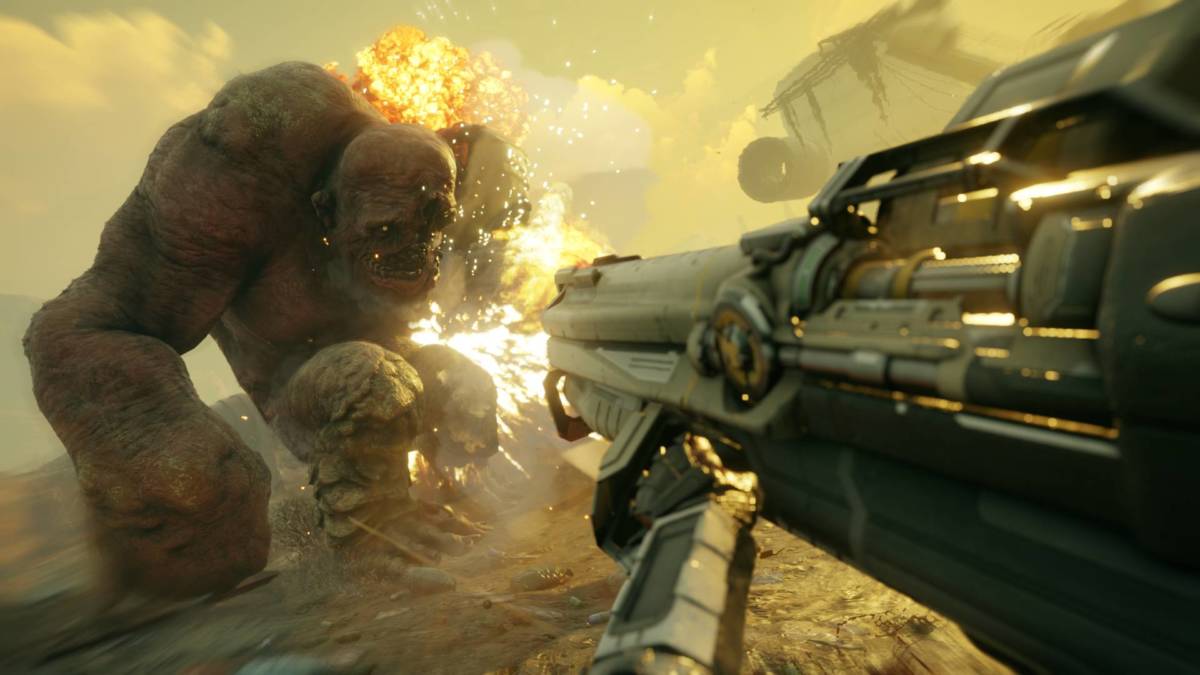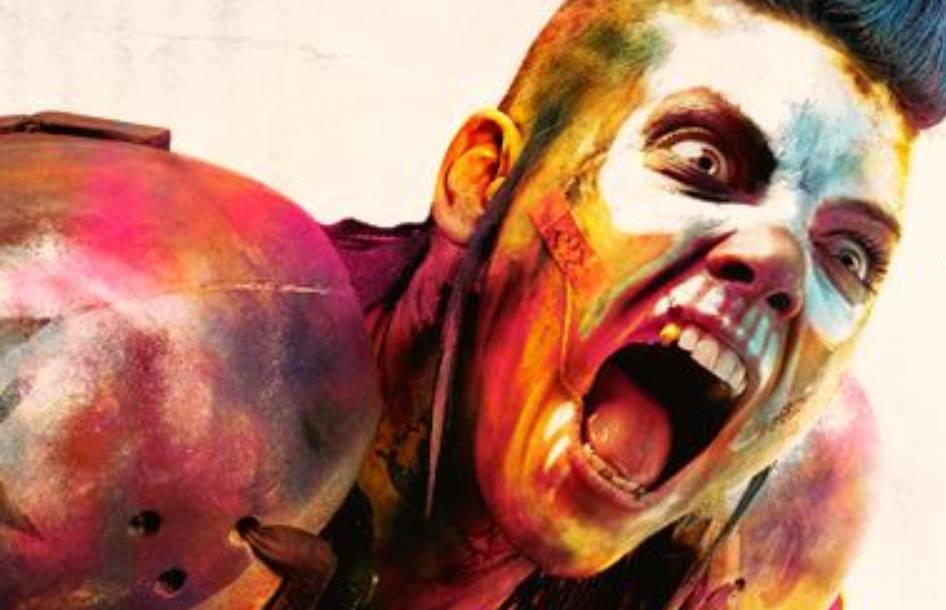A while back I critiqued the original RAGE from a story and narrative perspective, rather harshly. While I stand by my assessment of that game’s awful storytelling, I quite enjoyed my time with the game overall. What it lacks in character and writing it balances out with some pretty engrossing visuals, world-building and satisfying shooter gameplay.
RAGE has since become id Software’s forgotten shooter, at least relative to other franchises including the other id IP and publisher Bethesda’s catalog. Nonetheless, RAGE 2 will be upon us next year, and from the details and footage available it looks to be a much more mayhem-filled and over-the-top experience.
Here’s four things RAGE 2 can do to put the series on the map for the future.
1. Give us real characters and factions
RAGE gave us two primary factions – the “villainous” Authority and the Resistance. Neither of these factions are treated with any nuance, nor are they given any compelling development. The Authority are said (but never shown) by the Resistance to be the villains; their primary purpose is to provide faceless goons for late-game encounters, and they are never seen doing any of the bad stuff the civilians in the wasteland talk about.
The Resistance, meanwhile, gets their hands on you and immediately makes you their lackey, providing the minimal context for the latter half of the game’s missions. Aside from their leader and a few other NPCs found only in safe areas, the Resistance has no presence in the game world. No fellow fighters or companion characters, not even bodies found after battles with their foes. You’re their sole representative in the battle against the Authority, and ironically they exert more authority and control over you than any of the red-clad pseudo-Nazis.
The result of this minimal presence is that neither faction feels terribly important or impactful – nothing happens in the game world that isn’t a direct result of the player’s actions. There are no signs of conflict, no villainous characters and your allies do nothing but tell you stuff and/or sell you stuff. It feels less like a believable conflict and more like the thin context for a bunch of disconnected video game missions that it actually is.
The Authority is returning in RAGE 2, alongside a host of crazed raider/bandit gangs and mutants. This of course ensures a healthy variety of things to kill and destroy, but also provides an opportunity for better storytelling. Your character is said to be a Ranger, implying you’re some kind of lawman or force for order and relative peace in the wasteland. You’re left for dead with a helluva grudge against those who did it, and that implies there’s more to this game’s story than the errand boy simulator the first game gave us.
This coupled with what seems to be a much more overtly oppressive Authority and an open world full of factions provides a great opportunity for more in-depth interactions with characters and factions, beyond simple mission giving and supply restocking. It doesn’t need to shoot for the BAFTAs, but interacting with a varied cast of characters both off as well as on the battlefield and actually seeing life in the wasteland beyond us killing anything that moves would go a long way to making RAGE 2 into something more than just another open world shooter.
Surely not every last person outside the main settlements is in the “murder and mohawks” crowd?
2. Give the player a personality
Many of the FPS genre’s most famous heroes are mute or near-mute, and if your game doesn’t have your main characters’ voice and the personality it creates as a central aspect of the franchise, it’s perfectly acceptable to let the player be the sole architect of the character’s expression. When I say personality, I don’t necessarily mean voice.
Nonetheless, in a setting such as RAGE that seeks to engage the player beyond its shooting mechanics and introduce a world with characters and a story, it helps to get at least some idea of your avatar’s attitude, motivation and emotional state. id Software of course did this exceedingly well with DOOM 2016, featuring a verbally mute Doom Slayer who was regardless able to convey contempt for the UAC and Hayden’s platitudes, rage in his brutal killings of the game’s demonic foes, and even moments of sympathy and protectiveness, all through camera movements and hand gestures.
RAGE 2 would benefit from a protagonist who, even if not actually given choice throughout the story, at the very least expressed themselves through hand gestures, camera shakes and even simply in how they interact with items, objects and the way they fight. With RAGE 2’s apparent shift towards silliness and mayhem over the more grim story of the original, this is the perfect excuse to give protagonist Ranger Walker (I mean c’mon, even that name evokes cheesy 90’s action TV) an attitude that is conveyed with something other than rockets.
3. Keep progression and mechanics simple
There is a tendency among modern games to introduce convoluted RPG/skill systems – nearly every Ubisoft game has a skill or perk tree now, most online shooters have progression, and survival/loot systems are a dime a dozen.
Experience points and skill trees are only one way to enhance and engross players for the long haul in. DOOM 2016 relied on a limited set of mostly-linear upgrades to your suit and weapons as the game went on, ensuring that as the challenge ramped up, so too did your ability to rise to meet it. Systems like this, where your equipment and arsenal is updated and expanded rather than your characters’ stats and abilities, is often the better way to go for a shooter where your primary interaction with the world is through shooting.
RAGE handled upgrades in a few ways that were all anchored to the core mechanics – you could on a couple of occasions acquire a new, permanent outfit of your choice that suited your play style, and new ammo types and attachments for weapons made the limited arsenal more versatile and fun to use – even the lowly pistol is still useful late into the game with the more powerful ammunition types.
Zeroing in on expanding your capabilities through a smaller amount of carefully crafted and balanced items would keep the focus squarely on the shooting, driving and other core features of the game, and prevent gameplay that is designed around repetition and grinding. Instead, attention can be squarely placed on curated, challenging but balanced encounters that take into consideration the tools available to any player at that point.
This year’s God of War is another example of this general idea done well – there are “skills” to learn, but they simply add new moves to your existing weapons, and your stats and abilities come primarily from the equipment you carry and how you modify it. They give you new ways to actively participate in the game’s combat, rather than just making your existing moves inexplicably better all of a sudden through arbitrary stat increases.
RAGE 2’s short but sweet gameplay trailer definitely showcased a fun-looking arsenal as well as some seemingly Nanite-based offensive powers, and I hope they stick to upgrading and modifying these tools as your way of exercising your will over the game. I’d rather a smaller number of distinct and useful abilities tied to my arsenal than a bunch of numbers ticking up tediously.
“Play your own way” is great, but sometimes it’s better to play an expertly crafted combat encounter where the options come from how you overcome the fight with the tools you have and how you use the environment, not how much you’ve grinded and min-maxed the right build and whether your numbers are higher than the one floating over that mutant’s head.
4. Diversify the world
RAGE takes place in a Mad Max-style post-apocalyptic wasteland, with scattered settlements scraping by on scavenged resources and fending off mutant and bandit attacks. Its environments are mostly dusty deserts, caves and canyons, with some ruined industrial zones and some urban decay and high-tech Authority facilities late in the game.
RAGE 2’s announcement material showcased some glimpses of greener, more jungle/forested zones as well as a general tendency towards a color palette outside of gray and brown. This bodes well for the visuals and art direction of the title, and I hope they continue in this direction.
Just as important as the environments, however, is the enemy design. The bandit gangs in the original game each had their own styles and aesthetics to an extent, but other than minor variations in how they fought and what they were weak against the differences were negligible. I hope in this more bombastic and over-the-top sequel we get more contrast in the various gangs and enemy types, both in their visual designs to make them more interesting and distinct from one another as well as from a gameplay perspective, forcing vastly different tactics and tool usage for each. After all, without variety to populate it, even the most gorgeous environment is just empty scenery.
That’s all there is to say, for now at least. We’ve got probably another year at least before RAGE 2 hits our hard drives, and it certainly seems like a title worth keeping an eye on.
What are you hoping for out of the series’ sophomore entry?
Some of the coverage you find on Cultured Vultures contains affiliate links, which provide us with small commissions based on purchases made from visiting our site. We cover gaming news, movie reviews, wrestling and much more.






